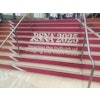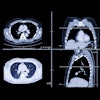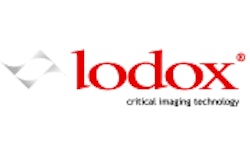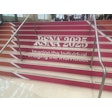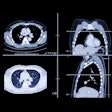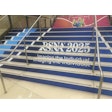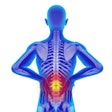IMCO Technologies
IMCO of Pewaukee, WI, will introduce Table Top CR, a low-cost computed radiography reader for low-volume applications such as hospital wards, medical clinics, private practices, or remote health stations, according to IMCO. The system includes automatic plate loading and erasing.
InfiMed
InfiMed will exhibit its StingRay flat-panel digital x-ray system for the first time as a commercial product after beginning production shipments of the system in April. The Liverpool, NY, company is marketing StingRay as a retrofit for existing radiography rooms. The strategy is designed to make digital radiography more affordable for facilities that want to keep their existing radiography equipment.
StingRay is based on Trixell’s Pixium 4600 flat-panel detector, which uses amorphous silicon as a scintillating material to convert x-rays into digital data. InfiMed will highlight the detector’s 17 x 17-in. matrix and its advanced DICOM capabilities, such as support for DICOM storage class and modality worklist for HIS/RIS integration.
Lodox Systems
Lodox is a South African company that will make its RSNA debut with a new low-dose whole-body digital radiography system, also called Lodox. The system is based on CCD technology with a fan-beam x-ray source that scans across the patient. The system uses a C-arm configuration and is best suited for trauma, emergency, pediatric, and military applications.
The company plans to emphasize the speed at which Lodox can image patients: The system completes a full-body image acquisition in 10 seconds, and images are available for viewing on the system’s workstation after 15 seconds. It is capable of scanning a new patient 32 seconds after the previous exam is completed.
The system has a 60-micron pixel size, collects images at 1.67 line pairs/mm in normal-resolution whole-body mode and 4.17 line pairs/mm in ultra-high-resolution mode, in which half the body is covered.
Lodox will be displayed as a work-in-progress, and the company is in the process of filing for FDA clearance for the system.
Philips Medical Systems
DigitalDiagnost VR is a new second-generation digital radiography system designed for chest imaging and other wall-mounted applications. The system uses a motorized digital flat-panel detector, measuring 17.5 x 17.5 inches, which provides a viewable image matrix of 3K x 3K pixels.
The Bothell, WA, vendor will use the RSNA show to display its PCR Compano system, an entry-level desktop CR unit first unveiled at the European Congress of Radiology in March. Compano is targeted at decentralized applications -- and for radiology departments that are considering a transition to filmless imaging.
Also in the digital radiography realm, Philips will unveil Unique, new multiresolution image processing software for its entire digital radiography line. The company says that Unique is ideal for soft-copy viewing and film printing without the need for individually adjusted post-processing.
Philips plans to address radiation dose concerns in dynamic x-ray studies by introducing IQX, a new technique that controls exposure parameters within x-ray pulses. IQX automatically regulates kV based on the selected object kV as well as the radiologic density of the subject. IQX’s kV regulation keeps patient exposure times in the 5-50 ms range, ensuring that every image is correctly exposed and free from motion blur, Philips said.
IQX is available on all Philips DSI-based radiography/fluoroscopy systems with Super CP generators.
Siemens Medical Solutions
Artis FA is a new single-plane angiography system that the Iselin, NJ, vendor is planning to debut. The system’s flexible C-arm enables positioning for all procedures, according to the company, while high-speed acquisitions allow for shorter injections in rotational angiography, which is helpful for 3-D reconstruction.
Artis FA also incorporates extended DICOM capabilities that enable the query and retrieval of images from other modalities into the exam room for comparison and reference.
Artis MP is an integrated C-arm and table system with 90/90 tilting capabilities. It has a high-speed rotation of 45° for rotational angiography, so users can conduct diagnostic angiography and vascular and nonvascular interventional procedures, in addition to routine R/F studies.
Swissray International
The Elmsford, NY-based firm is debuting expert 4000, a management and communication console for its direct digital radiography (ddR) product line. expert 4000 offers workflow improvements and links the company's SwissVision workstation with the vendor's expert-center support and training service, according to Swissray.
The company is also unveiling the second version of SwissVision. SwissVision II is a technologist workstation that can acquire radiographic images from ddR systems, computed radiography (via a CR plate scanner), or analog film (via a film scanner). This feature allows technologists to combine images from multiple sources into a single patient file, according to Swissray. SwissVision II also features several new software processing additions, including image combination for full-length spine scoliosis imaging, leg length studies, and computer-assisted detection.
Swissray has also added a new scintillator for its digital optical design (dOd) detector. The scintillator, which can be retrofitted to all ddR systems, improves detection efficiency and lowers patient dose, according to the company.
Among its works-in-progress, Swissray will showcase ddRFluoroscopy for the second year in a row. The company is emphasizing orthopedic applications for the technology, targeting high-resolution dynamic images for the evaluation of joint movement, according to Swissray.
Toshiba America Medical Systems
Toshiba of Tustin, CA, is ramping up its activities in digital x-ray, and plans to showcase Infinix VCi in its RSNA booth. The system uses CCD technology, and will be able to accept a flat-panel digital detector. FDA clearance is pending for the system, which will be shown as a work-in-progress.
Wuestec Medical
DR developer Wuestec is rolling out a film scanning and conversion service to aid customers moving to enterprise-wide film archiving and management. With the service, Wuestec will scan existing films into the DICOM 3.0 format and incorporate accompanying patient information into customer information systems.
Fees for the service will be waived if the institution signs up for the company's off-site storage offering, according to the Mobile, AL-based vendor. The company is also highlighting a marketing program to help small hospitals and imaging facilities convert to digital radiography.
By Brian Casey, Erik L. Ridley, and Jonathan S. Batchelor
AuntMinnie.com staff writers
November 14, 2001
Go to page:
Agfa through Imaging Dynamics
Copyright © 2001 AuntMinnie.com
